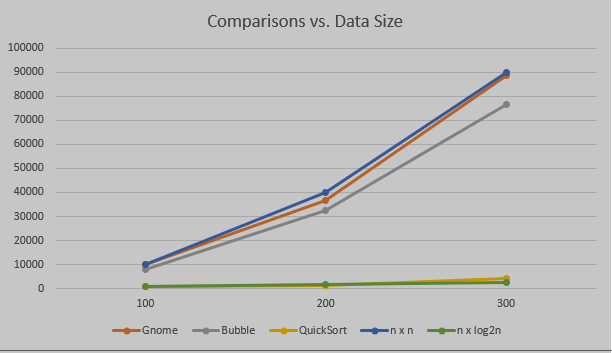Question
1. Add the Gnome Sort to the Bubble Sort and QuickSort program. See: https://en.wikipedia.org/wiki/Gnome_sort Count and display the number of comparisons needed for each of
1. Add the Gnome Sort to the Bubble Sort and QuickSort program. See:
https://en.wikipedia.org/wiki/Gnome_sort
Count and display the number of comparisons needed for each of the sorts.
2. Run the sorts with data set sizes of 100, 200, 300, 400, and 500.
3. Create an Excel data sheet displaying the above values of n and for each n the following results:
a. Comparisons for the Gnome Sort
b. Comparisons for the Bubble Sort
c. Comparisons for the QuickSort
d. Value of n2
e. Value n x log2n
4. Create an Excel line graph displaying the results. Should look something like (just the format, the values may be very different):

The Sorting Program:
package sorting;
import java.util.*;
import java.math.*;
/**
*
* @author mazurnm
*/
public class Sorting {
static int QuickCount = 0;
static int BubbleCount = 0;
static int GnomeCount = 0;
// print an array of integers, 10 elements per line
public static void print (int arr [])
{
int on_line; // number of elements printed on line
on_line = 0;
// Print each element in turn
for (int element : arr)
{
// need to go to a new line
if (on_line == 10)
{
System.out.println ();
on_line = 0;
}
System.out.print (element + " ");
on_line++;
}
}
// swap elements at indexes i1 and i2
public static void swap (int arr [], int i1, int i2)
{
int swapper;
swapper = arr [i1];
arr [i1] = arr [i2];
arr [i2] = swapper;
}
public static void BubbleSort (int arr [])
{
boolean swapped; // swapped is true, if values were swapped
int index; // current spot in the array
swapped = true;
// continue doing passes of the array until all
// elements are sorted
while (swapped)
{
swapped = false;
// do a pass of the algorithm
for (index = 0; index
{
// if out of order swap
BubbleCount++;
if (arr [index] > arr [index + 1])
{
swap (arr, index, index + 1);
swapped = true;
}
}
}
}
public static void gnomeSort(int[] anArray)
{
int first = 1;
while (first
{
if (anArray[first - 1]
{
first ++;
}
else
{
int tmp = anArray[first - 1];
anArray[first - 1] = anArray[first];
anArray[first] = tmp;
if (-- first == 0)
{
first = 1;
}
}
}
}
// Quicksort that just generates low and high indexes
public static void QuickSort (int arr [])
{
QuickSortHelp (arr, 0, arr.length - 1);
}
// recursive QuickSort, low is starting index into the
// array section to be sorted, high is the ending index
// into the array to be sorted
public static void QuickSortHelp (int arr [], int low, int high)
{
int pivot; // value separating sets (first in array)
int lowMover, // index into first part of array
highMover; // index into last part of array
// if one element, already sorted, so only concerned
// with case of more than one element
if (low
{
pivot = arr [low];
lowMover = low + 1;
highMover = high;
// as long as the small number is on the correct
// side, keep moving to the right
QuickCount++;
while (lowMover
{
QuickCount++;
lowMover++;
}
// as long as large number is on the correct side
// keep moving to the left
QuickCount++;
while (highMover >= low && arr [highMover] > pivot)
{
QuickCount++;
highMover--;
}
// repeat the above process as long as there are
// values to swap
while (lowMover
{
swap (arr, lowMover, highMover);
// as long as the small number is on the correct
// side, keep moving to the right
lowMover++;
QuickCount++;
while (lowMover
{
QuickCount++;
lowMover++;
}
// as long as large number is on the correct side
// keep moving to the left
highMover--;
QuickCount++;
while (highMover >= low && arr [highMover] > pivot)
{
QuickCount++;
highMover--;
}
}
// move pivot to the middle
swap (arr, low, highMover);
// call recursively to sort the two "halves"
QuickSortHelp (arr, low, highMover - 1);
QuickSortHelp (arr, highMover + 1, high);
}
}
/**
* @param args the command line arguments
*/
public static void main(String[] args) {
int [] arr = new int [1000]; // array to be sorted
// initialize the array with random integers
for (int i = 0; i
arr [i] = (int) (Math.random () * 10000);
System.out.println ("The original array is:");
print (arr);
BubbleSort (arr);
System.out.println (" The sorted array after Bubble Sort is:");
print (arr);
// initialize the array with random integers
System.out.println (" ");
for (int i = 0; i
arr [i] = (int) (Math.random () * 10000);
System.out.println (" The original array is:");
print (arr);
QuickSort (arr);
System.out.println (" The sorted array after QuickSort is:");
print (arr);
System.out.println (" Bubble comparisons: " + BubbleCount);
System.out.println ("QuickSort comparisons: " + QuickCount);
System.out.println (" ");
}
}
*I added the gnome sort but I don't know what to do next.
Comparisons vs. Data Size 100000 90000 80000 70000 60000 50000 40000 30000 20000 10000 100 200 300 GnomeBubble-QuickSort-nxn x log2n Comparisons vs. Data Size 100000 90000 80000 70000 60000 50000 40000 30000 20000 10000 100 200 300 GnomeBubble-QuickSort-nxn x log2n
Step by Step Solution
There are 3 Steps involved in it
Step: 1

Get Instant Access to Expert-Tailored Solutions
See step-by-step solutions with expert insights and AI powered tools for academic success
Step: 2

Step: 3

Ace Your Homework with AI
Get the answers you need in no time with our AI-driven, step-by-step assistance
Get Started


